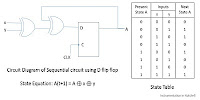The digital logic circuits are classified into two major categories. They are, (a) Combinational Circuits and (b) Sequential Circuits. In practice, both the combinational and sequential circuits are together used in a variety of applications. However, there exist contrasting differences between the two and it is presented here.
Combinational Circuit
|
Sequential Circuit
|
A combinational circuit is a
logic circuit whose output at any instant depends upon the present
combination of inputs.
|
A sequential circuit is a
logic circuit whose output at any instant depends upon the present inputs and
also the past inputs and outputs.
|
There is no need to store
previous states and outputs.
|
There is a need for storage
of past outputs. So, sequential circuits employ storage elements called
memory.
|
There is no feedback in
combinational circuits.
|
The past outputs are stored
in memory and fed back to the logic circuit to determine the present output.
|
The combinational circuits
are independent of clock signals.
|
Sequential circuits are
classified into two types based on the timing of feedback signals. They are,
Synchronous sequential circuits that use clock pulses and Asynchronous
sequential circuits that do not use clock pulses.
Also read: Synchronous Sequential Circuit vs Asynchronous Sequential Circuit |
The combinational circuit
need no triggering.
|
Synchronous sequential
circuits needs to be triggered for its operation.
|
The behavior of the combinational circuit can be defined by either Boolean expression or Truth table.
|
The behavior of the sequential circuit can be defined using State equation (also known as
Transition equation) or State table.
|
The application of
sequential circuits are shift registers, flip flops, counters, memory devices
etc.
|














A good article.
ReplyDeleteThanks. Keep following. Share to others too.
DeleteTqsm
ReplyDeleteTq
ReplyDeleteyour layout is not responsive on desktop
ReplyDeleteThank you for your feedback. Will look into it.
Delete